Custom dashboards
In addition to predefined dashboards, custom dashboards let you create personalized views of your contact center data. You can select, arrange, and visualize the metrics that matter most to your business.
Use custom dashboards to monitor key performance indicators, track trends, and make data-driven decisions tailored to your specific needs.
Visualizations
Visualizations are interactive, multi-layer analytics that let you add and slice data based on multiple metrics. Visualizations are the most extensive report types and can be used as standalone reports or as part of your custom dashboards.
To access Visualizations, go to Conversations → Analytics → Visualizations in the web interface.
With Visualizations, you can:
- View a list of visualizations
- Create a new visualization
- View details of a visualization by clicking the information icon
- Search for visualizations by partial or complete name
- Filter visualizations, for example by visualization type or last updated
- Sort visualizations using the table headers
- Export visualizations
- Set the number of visualizations displayed per page
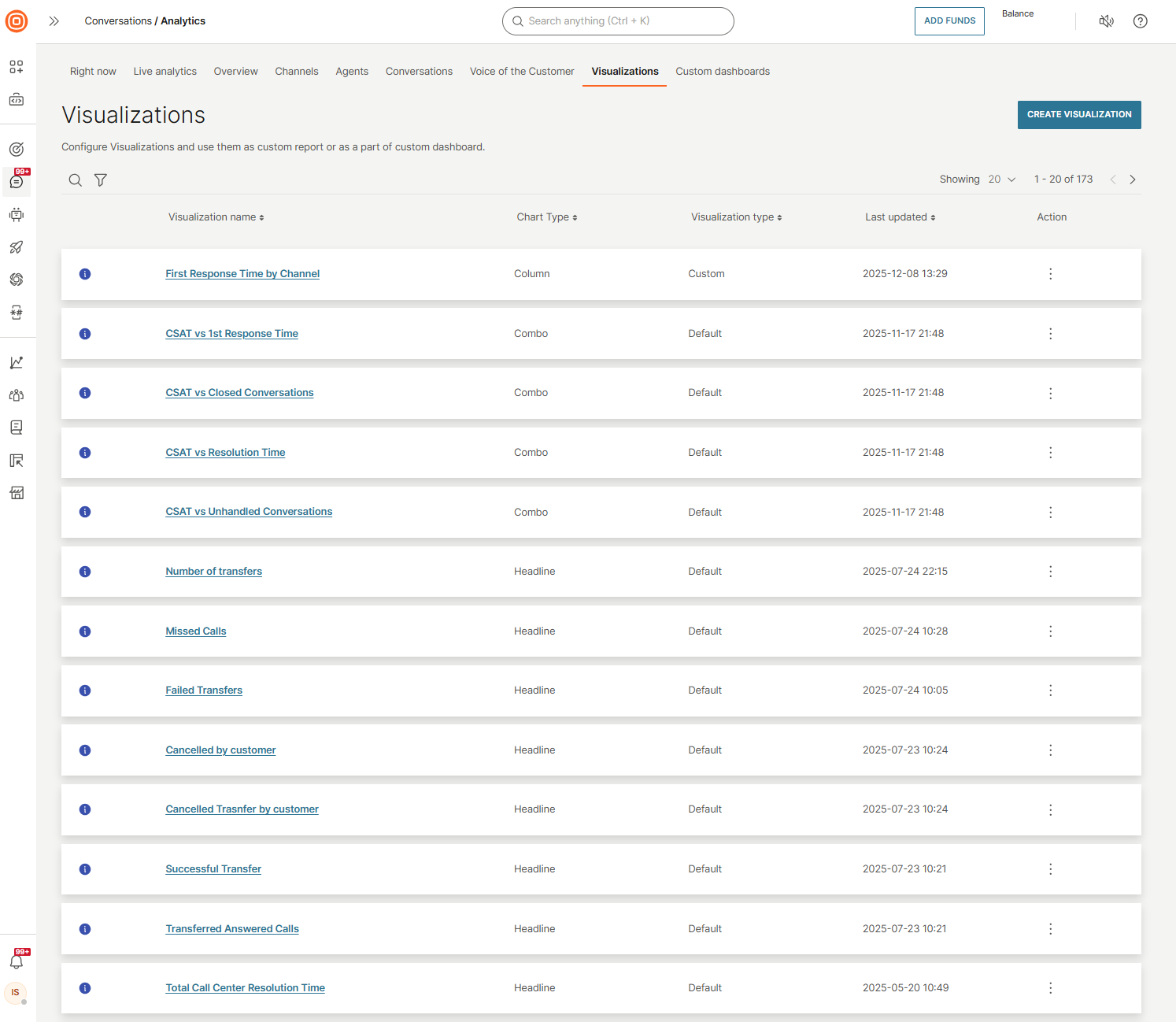
Visualizations editor
Use the Visualizations editor to:
- Create a visualization
- View a list of visualizations
- Export a visualization
- Edit a visualization
- Delete a visualization
To access the editor, go to the Visualizations tab in the Conversations Analytics section and select Create visualization.
When the page opens, you will see the following options:
- Data catalog: Contains facts, metrics, and attributes. Expand menu items to view available data.
- Facts: Quantitative data you can add to the visualization.
- Metrics: Quantitative data you can add to the visualization.
- Attributes: Qualitative data you can add to the visualization.
- Filter options for the data catalog: Click the relevant data type (metrics, facts, or attributes) to view a list of items of that type.
- Search: Search for data items by partial or full name.
- Visualization type: Change the chart type as needed. The system updates the visualization to match the selected type. Each chart type may support specific data types. Example: The Stack by field is available for a column chart but not for a table.
- Active zones: Drag and drop items from the data catalog to these areas of the canvas. The editor guides you on supported data items for each zone.
- Ad hoc metrics: Use basic arithmetic functions to create metrics. Click the + sign to add more.
- Filter: Filter the visualization by specific criteria. Drag and drop the Date or any attribute from the data catalog, or use the filter button to select attributes. The editor displays a message if data cannot be filtered.
- Sort: Sort data alphabetically, numerically, or chronologically. Sorting is available for bar, column, area, combo, bullet, pie, donut, and heatmap charts.
- Undo, Redo, and Clear: Undo or redo changes. Click Clear to remove all data from the visualization.
- Open: View an visualization. Filter to view only visualizations you created, or search by name.
- Save: Save your visualization.
- Export: Choose the format to export your visualization.
- Configuration: Format the visualization, such as changing colors or positioning the legend. Some charts may have limited configuration options.

Create visualization
Follow these steps to create a visualization:
- On the Analytics → Visualizations tab, click Create visualizations.
- Choose a visualization type. Each chart type supports specific data types.
- Drag and drop one or more data items (fact, metric, attribute) from the data catalog to the active zones. You can view the data immediately after you add items to the fields. To create a new metric, add at least two data items.
- (Optional)
- To get more detailed data, drag and drop the Date or an Attribute to the Rows/Columns field (only for tables) or to the View by, Trend by, or Attribute fields (for other chart types).
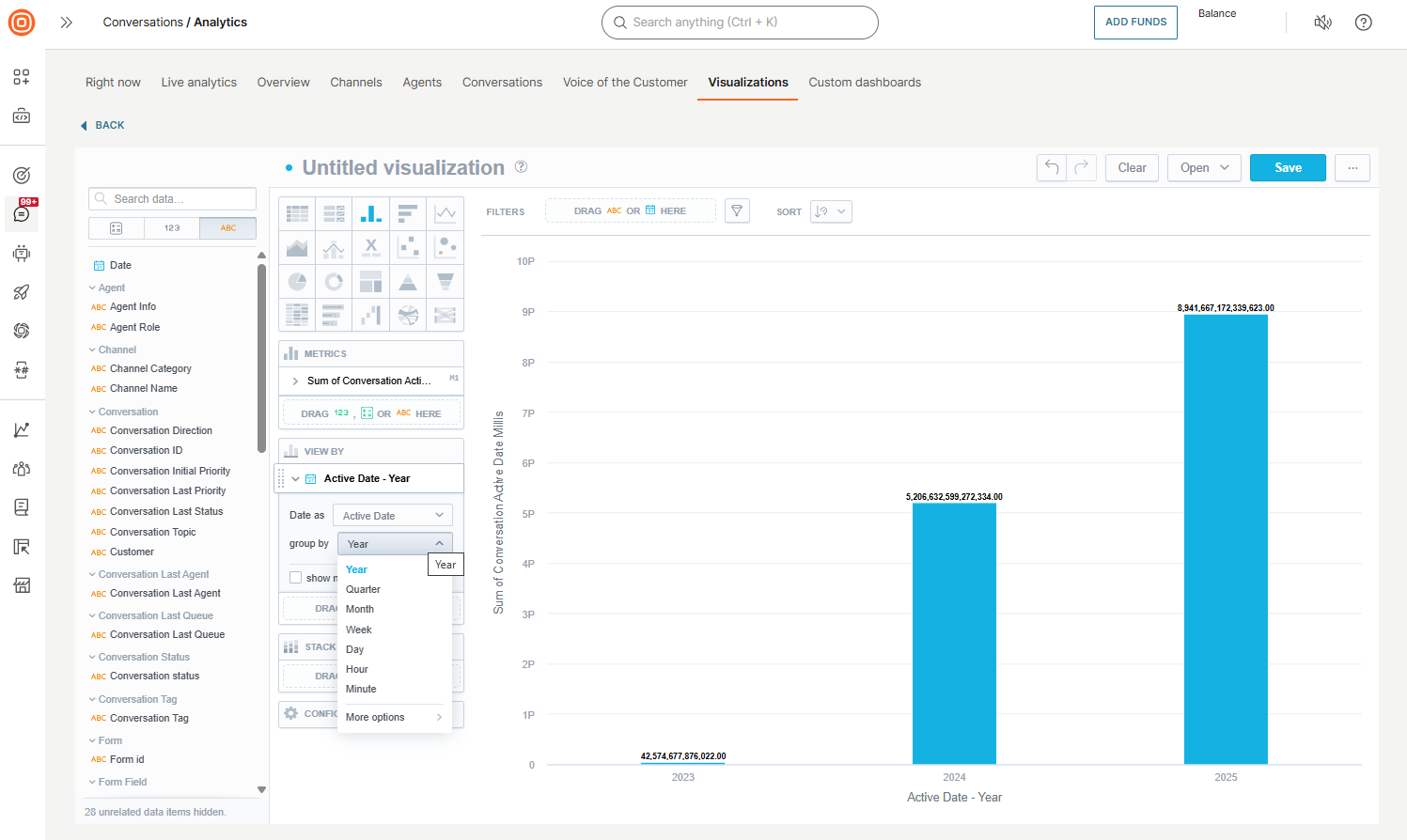
- To split the data into stacked groups, drag and drop an Attribute to the Stack by or Segment by field. For Line charts, there must be only one data item in the Metrics field.
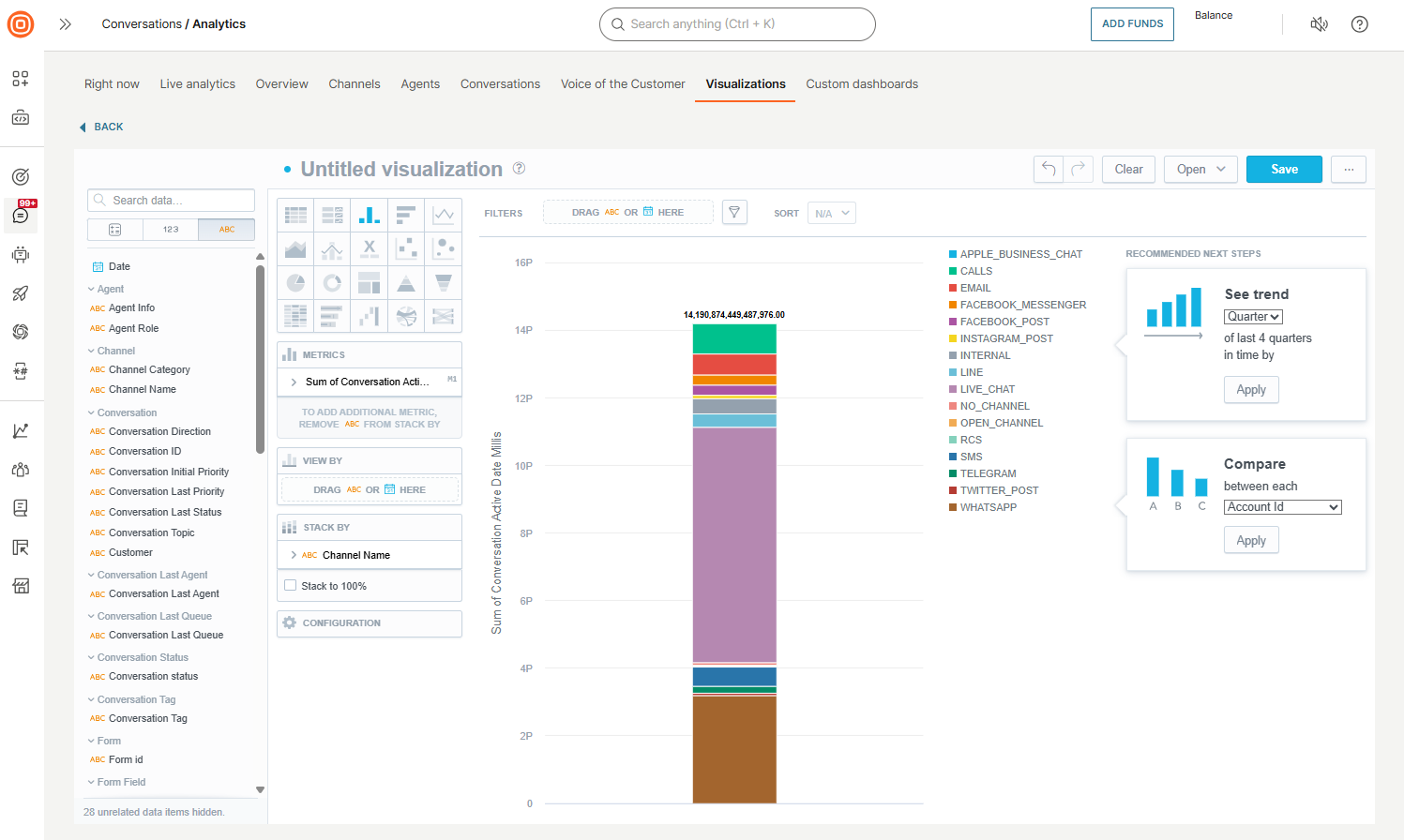
- To format the chart, use the Configuration options.
- To make changes, use the Undo, Redo, and Clear options. To delete a data item, click the item in the editor and drag it to the left. Use additional customization options.
- To get more detailed data, drag and drop the Date or an Attribute to the Rows/Columns field (only for tables) or to the View by, Trend by, or Attribute fields (for other chart types).
- Name your visualization.
- Select Save.
Use one or more of the following options to customize your visualization further.
Refine data items
You can refine facts, metrics, and attributes. In the Metrics section:
- Select the +Add attribute filter button to add more attributes to your visualization. All filters that you add are applied immediately.

- Besides this, you can also do the following:
- Display this filter as a percentage
- Format the data values
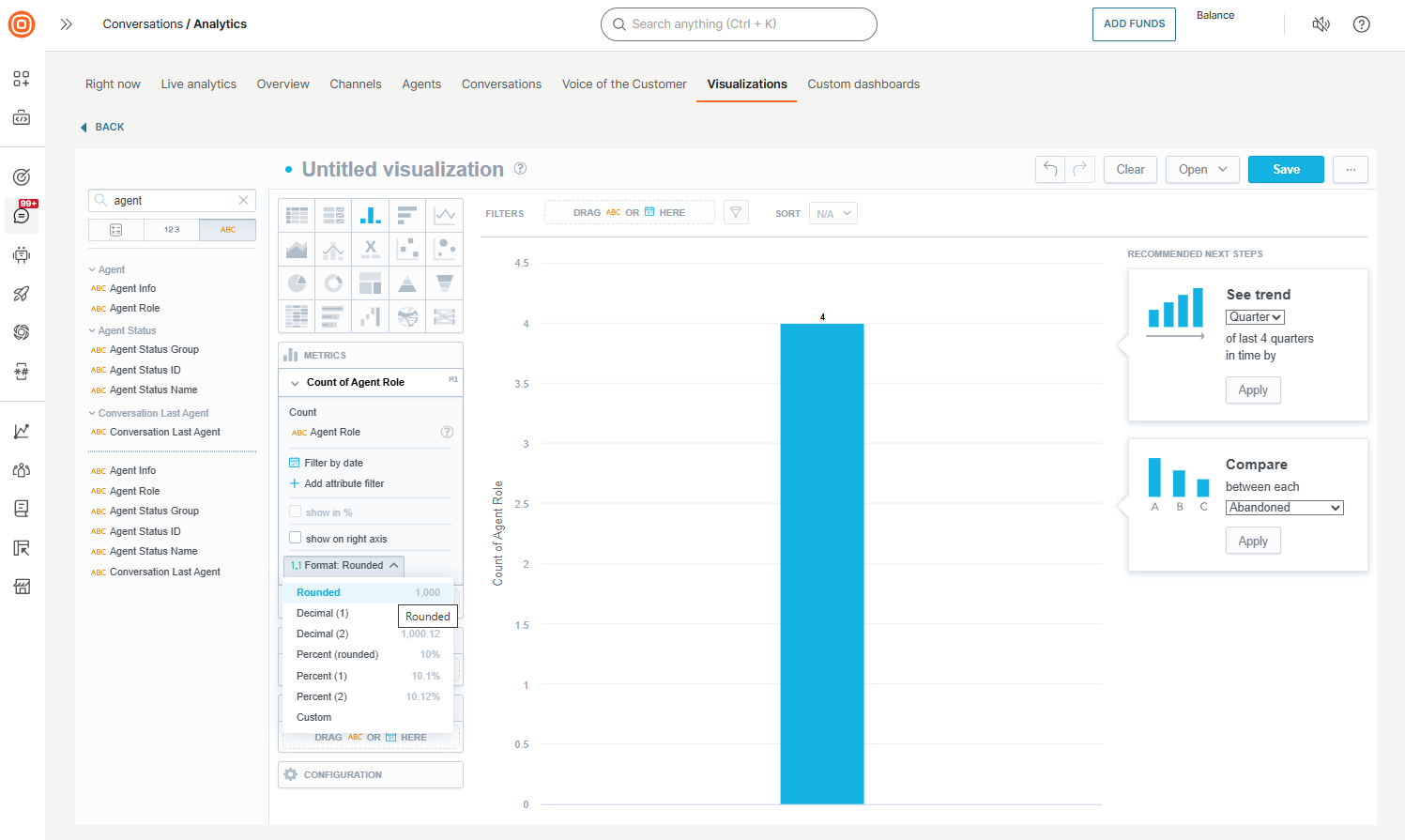
Add filters to the visualization
This section is for filtering the visualization. For details about filtering the Attribute section, refer to the Refine data items section above.
To filter the visualization:
- Drag and drop the Date and other attributes to the filter at the top.

- Select the item added to the filter and choose the needed options (optional).
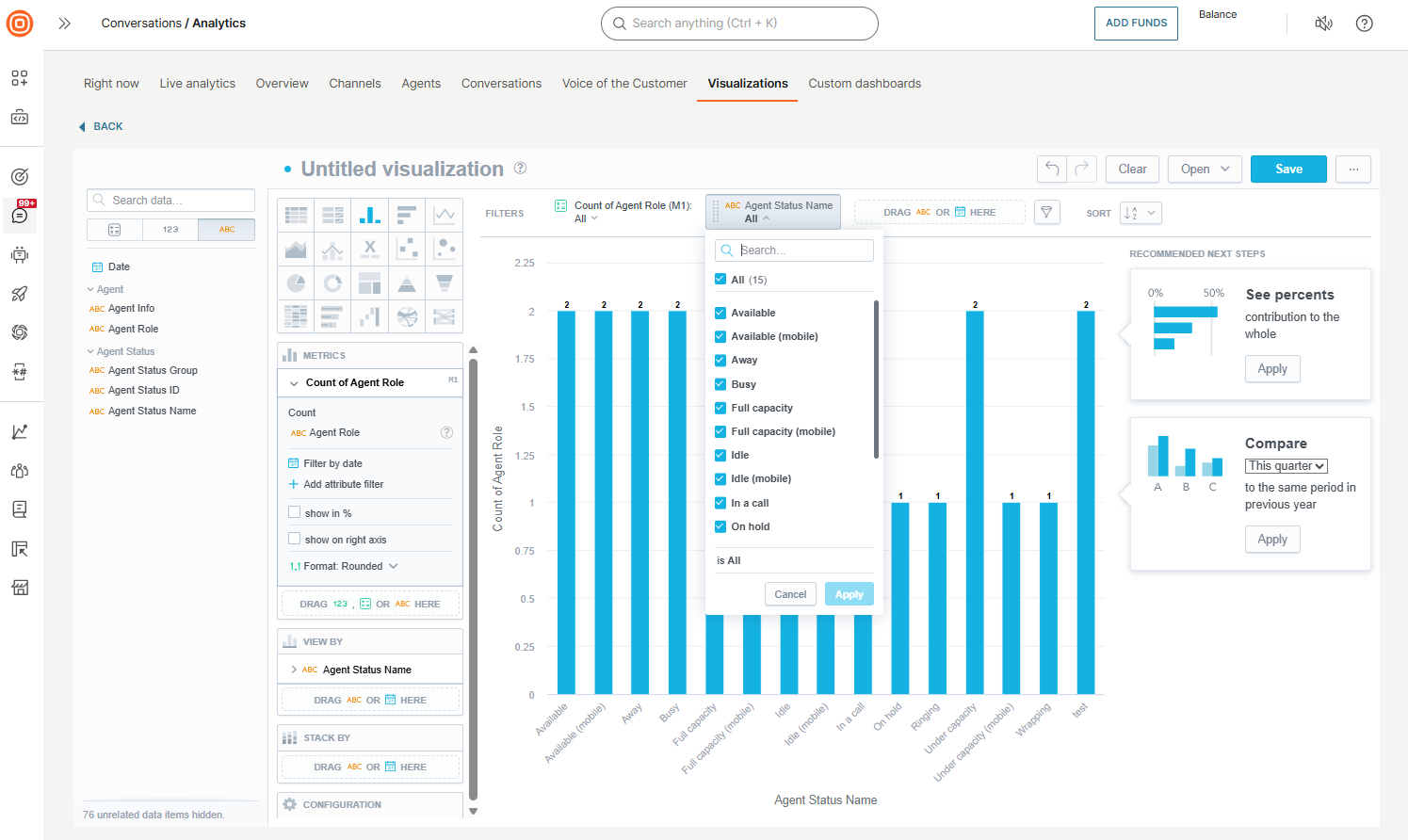
- Select the filter icon and choose the filters you wish to apply (optional).

Export visualization
In the Visualizations tab, select the three dots next to an visualization and choose one of the following file formats:
- .csv
- .xlsx
The visualization is downloaded as a static file.
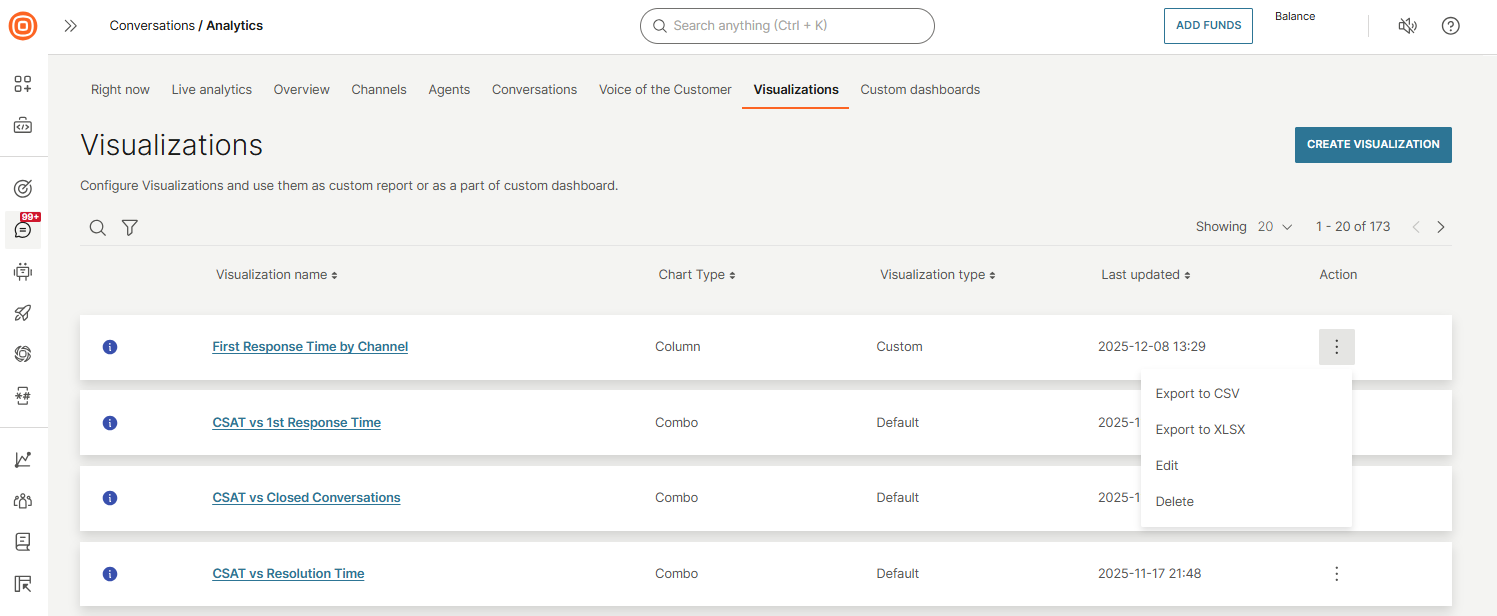
Custom dashboards
Dashboards are visual representations of data. Create custom dashboards to obtain specific, relevant information about the performance of your conversations or agents.
With custom dashboards, you can:
- Track changes to your KPIs
- Compare current data across time periods
- Add, slice, and filter data
Dashboards can include one or more of the following components:
- Visualizations: Multi-layer analytics that let you add and slice data based on multiple metrics.
- Key performance indicators (KPIs): Single-metric analytics displayed in numeric format (whole number, decimal, or percentage).
- Attribute filter: Additional filters you can add to standard filtering options to filter reports by specific Conversations components. These filters are predefined and based on standard Conversations fields.
Dashboards can contain multiple items of the same type (for example, multiple visualizations). All elements on a dashboard should work together to fulfill a common purpose.
To access dashboards, go to Conversations → Analytics → Custom dashboards.
You can:
- View dashboards: By default, the latest dashboard you created is displayed. To view other dashboards, select from the Custom dashboards menu
- Create dashboards: Use custom metrics to customize an existing standard report or create a new custom dashboard from scratch
- Edit dashboards
- Export dashboards (supported file type: .pdf)
- Share dashboards with others in your organization
Create dashboard from existing standard report
- On a standard report visualization, select the menu button and then click Explore from here.
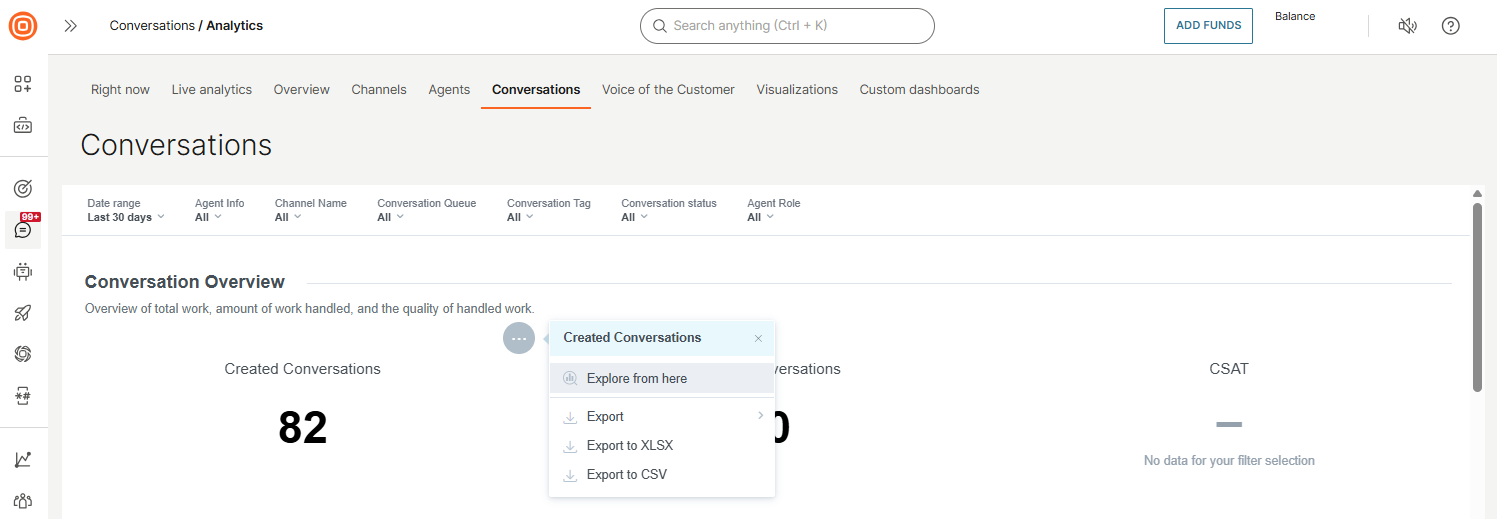
- The report opens in the visualization editor. For more information about the visualization editor, refer to the Visualizations section.
- Add other reporting elements to the editor.
- Select Save.
Create dashboard from scratch
Follow these steps to create a new dashboard:
-
Go to Conversations → Analytics → Custom dashboards and in the drop-down menu, select + Add dashboard.

-
Enter the dashboard name. Choose one of the following dashboard availability options:
- Public: Accessible by everyone who has access to Conversations Analytics
- Shared: Shared with specific users or groups
- Private: Accessible only to the creator of the dashboard
-
Select Create.
-
Drag and drop one or more of the following items to the dashboard editor. You can add more than one item of the same type (for example, multiple attributes). The editor provides guidance about where you can add each item.
Attribute filter: After you add the Attribute Filter element, search for or choose an attribute from the list (for example, channel name or CSAT score). For each attribute, choose the values to filter. By default, all values are selected. You can add or edit these filters at any time, for example, if there are new reports.
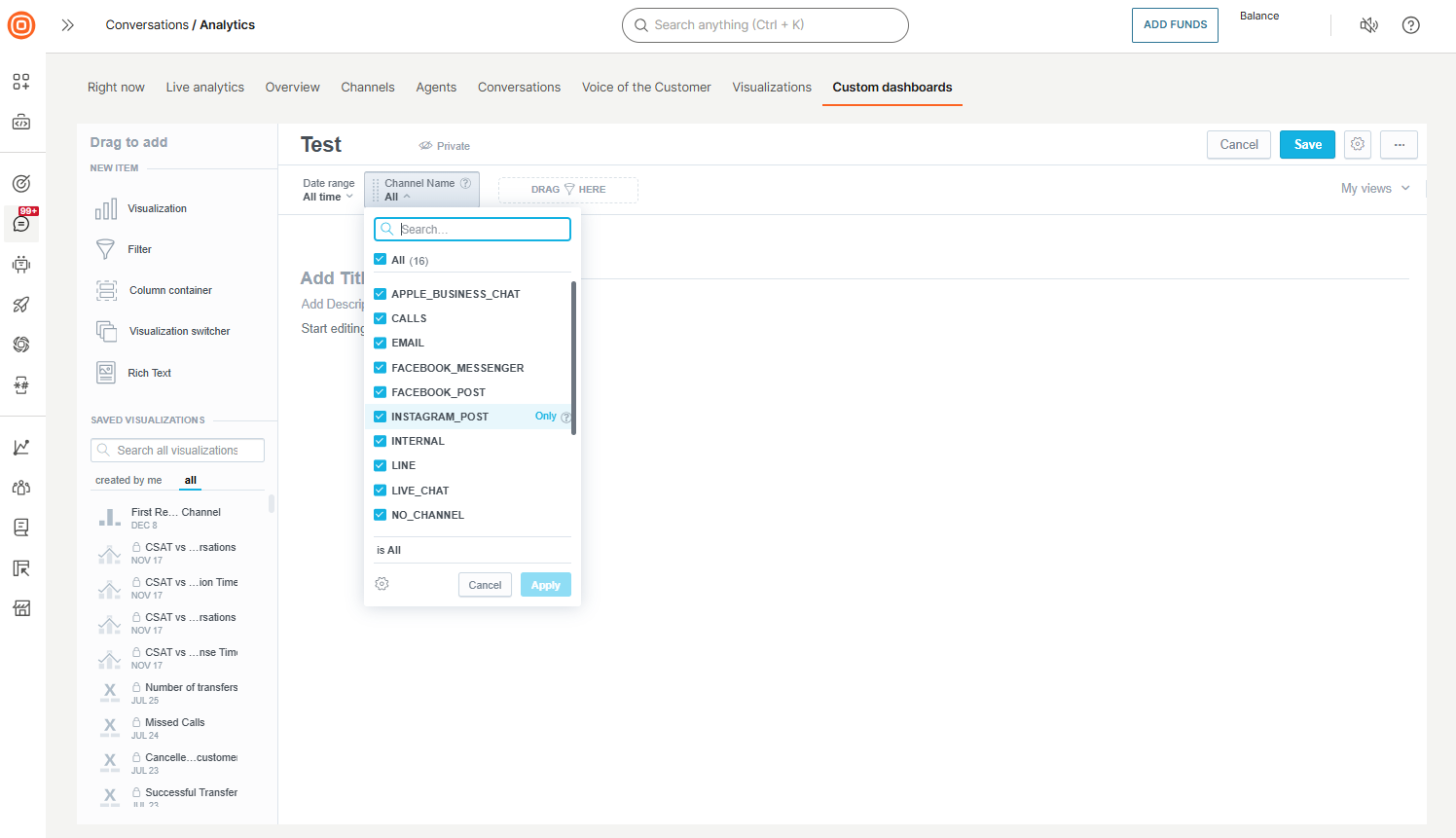
Key performance indicator (KPI): After you add the KPI element, search for or choose a metric from the list (for example, session duration or new users). You can also do the following:
- Filter by date or by one or more attributes. Choose an attribute in the Filter by section.
- Compare data between time periods. Choose the time period in the Comparison section. You can also choose whether to display the result in green or red.
- Drill into a specific dashboard. Choose an existing dashboard in the Drill into dashboard section. When your custom dashboard is ready, you can click the KPI to view the selected dashboard.
Visualization: Create a new visualization to display results by multiple data types. For more information, refer to the Visualizations section.
Saved visualizations: Search for an visualization or choose an existing one from the list to display results by multiple data types. You can add visualizations that you created or those that are shared with you. After you add the visualization, click the visualization to view the menu options. You can do the following:
- Add filters or hide the visualization title: Click Configuration
- Make changes: Click Edit
- Enable zoom option for the visualization: Click Interactions → Zoomable visualization
- Drill into data. For more information, refer to the Drill into data section.
-
Add titles and descriptions for each section.
-
To configure or delete a KPI or visualization, click the item to get the menu options, and then click Remove from dashboard (optional).
-
To delete an attribute filter, click the item and drag and drop it to the left.
-
Select Save.